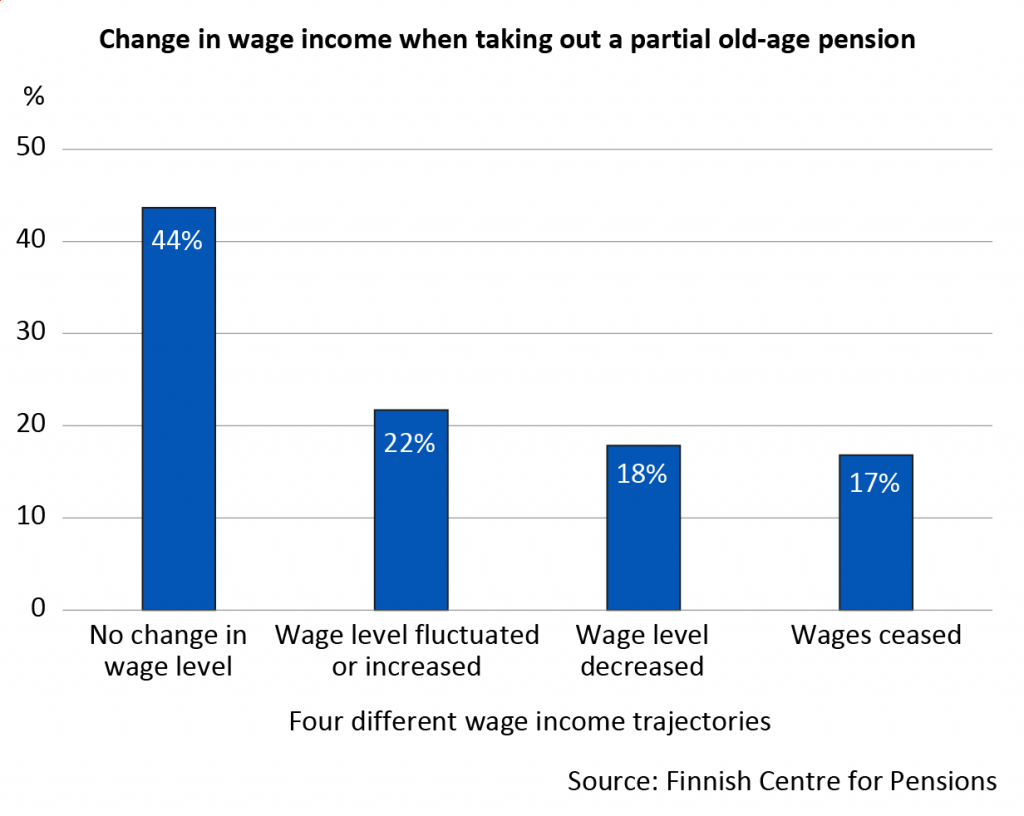Majority does not cut down on working while drawing a partial old-age pension

Many persons who draw the partial old-age pension continue working as before, with-out changes to their wage level. Only every fifth person on this pension benefit seems to have cut down on working. This is evident in a recent study by the Finnish Centre for Pensions.
After taking a partial old-age pension, around 60 per cent of wage earners saw their earnings remain the same, fluctuate as before taking out the pension or increase when followed up for a year after the start of the pension. This suggests that working was not reduced after taking the pension.
A small share – around every fifth – of those selecting to draw the partial old-age pension continued working with a lower wage level, that is, apparently cut down on working.

Partial old-age pension desired to extend working lives
The partial old-age pension provides the opportunity to flexibly combine work and pension, with the aim to extend working lives. The idea was that reduced working while drawing the pension would extend working lives.
“Based on wage income data, a large share of the recipients of this benefit do not reduce working. Therefore the partial old-age pension does not seem to extend working lives substantially. Previous research has shown that working 61-year-olds who draw the partial old-age pension retire on a full old-age pension earlier than others”, explains Senior Researcher Ilari Ilmakunnas (Finnish Centre for Pensions).
According to him, some may find it difficult to cut down on working hours after taking out the partial old-age pension if, for example, the employer is unfavourable to the arrangement.
Partial old-age pension reduced working life for some
The partial old-age pension may also reduce the working life of some recipients of this benefit. This happens if the wage earner exits working life with the help of this pension benefit, or if receiving the pension and unemployment benefits together prolongs unemployment.
During the follow-up period, the wage income ceased for 17 per cent of those selecting the partial old-age pension. Nearly half of them received unemployment benefits at some point during this period.
“As a rule, unemployment started close to the time of taking out the partial old-age pension. In addition, a small share of wage-earners seems to exit working life completely after taking out the partial old-age pension since not all received unemployment benefits or a sickness allowance during the follow-up period”, Ilmakunnas explains.
25- and 50-per-cent partial old-age pensions used partly in different ways
Three in four wage earners who drew a partial old-age pension took out 50 per cent of their accrued pension. This was the case particularly among those whose wage income stopped during the follow-up period.
“The higher partial old-age pension is used to compensate for the significantly reduced income”, assesses Senior Researcher Susanna Sten-Gahmberg (Finnish Centre for Pensions).
Those who chose the 25-per cent pension often continued working with a lower wage than before, that is, they reduced their working.
“If the partial old-age pension extends working lives, it can be assumed to do so particularly for those who take out the 25-per-cent partial old-age pension.”
Clear gap in wage income development between public and private sector workers
Public sector wage earners were more likely than private sector wage earners to continue working at the same or a lower wage level than before taking out the partial old-age pension. Private sector wage earners, on the other hand, stopped receiving wages or had fluctuating wages more often than public sector wage earners.
“Starting to work part-time may be easier in the public sector. In the private sector, on the other hand, there was more variation in monthly wages even before taking out the partial old-age pension than in the public sector”, says Ilmakunnas.
The study focuses on wage earners whose wage data could be monitored for 14 months before and 12 months after the partial old-age pension began. They did not reach their retirement age during the review period.
Research publication: Wage income before and after taking out a partial old-age pension (Summary in English)
Partial old-age pension steadily more popular
- Around every fifth takes out the pension before reaching their retirement age. The partial old-age pension has been clearly more popular than its predecessor, the part-time pension
- Most persons take out the partial old-age pension as soon as it is possible, that is, at age 61.
- Around 80 per cent of all persons who have taken out the partial old-age pension take out 50 per cent of their accrued pension.
- Men, self-employed persons, private sector workers, unemployed persons or those with a longer working life are more likely than others to take out the partial old-age pension before retiring on a full old-age pension.
